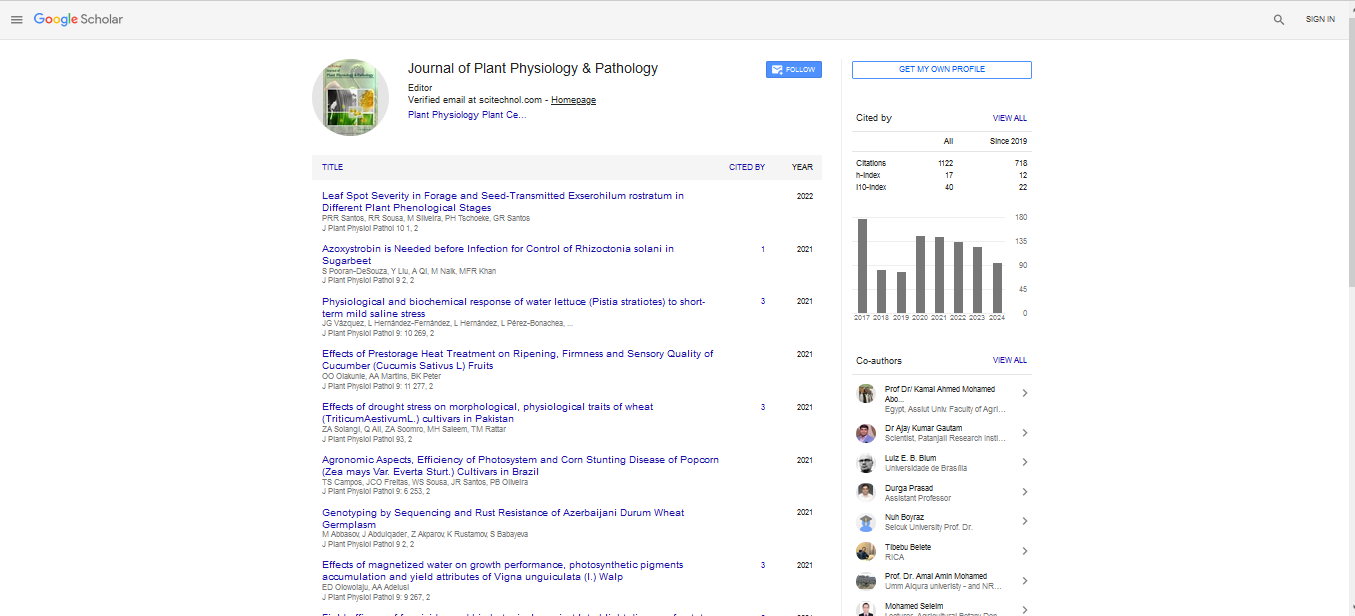Commentary, J Plant Physiol Pathol Vol: 12 Issue: 2
Exploring the Impact of Carrot Root Rot on Agricultural Production
Peng Wu*
1Department of Plant Genetics and Breeding, Guangxi University, Nanning, China
*Corresponding Author: Peng Wu,
Department of Plant Genetics and Breeding,
Guangxi University, Nanning, China
E-mail: peng.wu98@edu.cn
Received date: 23 February, 2024, Manuscript No. JPPP-24-131784;
Editor assigned date: 26 February, 2024, Pre QC No. JPPP-24-131784 (PQ);
Reviewed date: 12 March, 2024, QC No. JPPP-24-131784;
Revised date: 20 March, 2024, Manuscript No. JPPP-24-131784 (R);
Published date: 28 March, 2024, DOI: 10.4172/2329-955X.1000338
Citation: Wu P (2024) Exploring the Impact of Carrot Root Rot on Agricultural Production. J Plant Physiol Pathol 12:2.
Description
Carrot root rot, caused by various fungal pathogens such as Pythium spp., Rhizoctonia solani, and Fusarium spp., represents a significant threat to agricultural production globally. In this explanation, the impact of carrot root rot on agricultural production, exploring its implications for crop yield, quality, and economic sustainability will be discussed. Carrot root rot can lead to substantial yield losses in affected fields. Infected plants exhibit stunted growth, reduced vigor, and premature wilting, ultimately resulting in diminished crop yields.
The disease can affect both the quantity and quality of harvested carrots, leading to significant economic losses for growers. Yield reductions due to carrot root rot can range from moderate to severe, depending on factors such as pathogen virulence, environmental conditions, and crop management practices. In addition to yield losses, carrot root rot can impact the quality of harvested carrots. Infected roots may develop lesions, discoloration, and rotting, rendering them unmarketable or unsuitable for human consumption. The presence of rot and decay in harvested carrots not only reduces their market value but also compromises food safety and consumer confidence. Quality degradation caused by carrot root rot can lead to rejection by buyers, increased post-harvest losses, and reputational damage to growers and suppliers. The economic impacts of carrot root rot extend beyond direct yield losses and quality degradation.
Growers incur additional costs associated with disease management, including fungicide applications, cultural practices, and labor inputs. Investments in disease prevention, detection, and control measures add to production expenses and reduce overall profitability. Moreover, crop losses due to carrot root rot can have ripple effects throughout the agricultural value chain, affecting input suppliers, distributors, retailers, and consumers. Economic instability resulting from reduced carrot production and market volatility further exacerbates the financial burden on farming communities. Carrot root rot management practices, such as chemical fungicide applications and soil fumigation, can have environmental consequences. Pesticide runoff from agricultural fields can contaminate water sources, harm non-target organisms, and disrupt aquatic ecosystems.
Soil fumigation with chemical nematicides and fungicides can contribute to soil degradation, loss of beneficial microorganisms, and long-term environmental pollution. Sustainable disease management strategies that minimize reliance on synthetic chemicals and promote ecological balance are essential for reducing the environmental impacts of carrot root rot control measures. Addressing the impact of carrot root rot on agricultural production requires a multifaceted approach focused on long-term sustainability. Integrated disease management strategies that combine cultural, biological, and chemical control tactics can help mitigate the effects of carrot root rot while minimizing environmental harm. Crop rotation with non-host plants, soil amendments, and biocontrol agents can suppress pathogen populations and reduce disease pressure over time. Breeding and deploying carrot varieties with genetic resistance or tolerance to root rot pathogens offer sustainable solutions for disease prevention and management.
Carrot root rot poses significant challenges to agricultural production, affecting yield, quality, economic viability, and environmental sustainability. By understanding the impact of this disease on crop production systems, growers, researchers, and policymakers can develop targeted interventions to reduce its effects and promote resilient farming practices. Investing in disease surveillance, research, and extension services is critical for enhancing disease management strategies and safeguarding the long-term sustainability of carrot production. Collaborative efforts across the agricultural sector, including public-private partnerships, knowledge sharing networks, and stakeholder engagement, are essential for addressing the multifaceted challenges posed by carrot root rot and ensuring the continued success of carrot farming worldwide.
 Spanish
Spanish  Chinese
Chinese  Russian
Russian  German
German  French
French  Japanese
Japanese  Portuguese
Portuguese  Hindi
Hindi 
